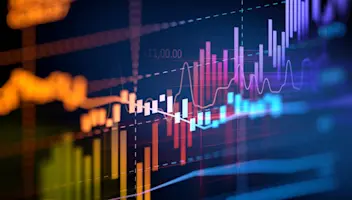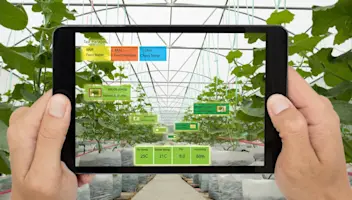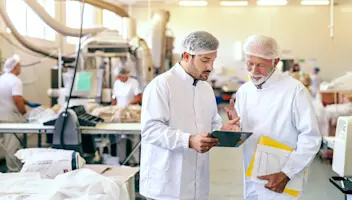IoT Applications from Farm to Fork: Use Cases Across the Supply Chain
IoT Applications from Farm to Fork: Use Cases Across the Supply Chain
IoT Applications from Farm to Fork: Use Cases Across the Supply Chain
17 Nov 2021
Jack Payne
The Internet of Things (IoT) and the connected smart devices that constitute it have already become a part of our daily lives. Our mobile devices and AI-powered assistants are the most prominent examples of this technology and its importance to society. But it’s in the business world that IoT may have the most profound impact, as it’s a key component of “Industry 4.0” and a new age of transparent, data-driven operations.
As a food and beverage industry professional, you likely recognize how much your business stands to gain from this development, as connected devices can serve to improve traceability, quality, sustainability and efficiency at each stop along the supply chain. Companies are clearly buying in to this idea, with IoT technology in food and beverage manufacturing expected to reach a valuation of $8.43 billion by 2025.
What’s more, IoT ranked second on the list of technologies most likely to have the greatest impact on food and beverage organizations over the next 5 years according to the IDC Food and Beverage Global Trends and Strategic Insights whitepaper commissioned by Aptean. Clearly, industry leaders see the potentially paradigm-shifting applications of these IoT tools in supply chain management and are eager to implement them to achieve better results.
To illustrate the power of IoT in the food and beverage space, let’s take a look at how organizations like yours can employ connected devices to streamline processes and improve outcomes from farm to fork.
IoT Applications for Farmers, Packers and Harvesters
Farming operations continue to grow more intelligent and sophisticated, and smart technology is now playing a major role in this movement toward modernization. The results are evident in the higher quality and quantity of product, as well as the greater visibility these businesses have into their own performance.
Sensors in the field can connect via WiFi and update back-end systems with the latest readings on soil acidity, temperature, moisture and other variables to help ensure that optimal growing conditions and harvest times are met. RFID “beacons”—tiny coin-shaped devices powered by watch batteries—can be used to track farming equipment, including which employees are using it and what activities they’re performing.
One other area in which the IoT can serve at this step in the supply chain is waste reduction. Connected climate controls in storage areas and delivery trucks can monitor key environmental parameters and flag deviations from acceptable ranges so that maximum shelf life and freshness can be preserved.
IoT Applications for Manufacturers and Processors
Factory floors at food and beverage manufacturing companies are also seeing rapid adoption of smart devices, as they can have considerable impact on traceability and quality control efforts. The use of these devices starts as soon as raw materials are received, as handheld barcode scanners can now capture important information, relay it to your ERP system in real time and give staff the visibility they need to track ingredient origins in the case of a food safety emergency.
Then, along the production line, connected thermometers, scales and imaging equipment can collect vital quality data so that processes can be revised to achieve better results and finished goods that are not up to specifications can be identified and removed from the run. What’s more, the ability of this equipment and other IoT-enabled machinery to communicate with a central system aids in predictive maintenance, as notifications for regular repairs and checks can facilitate proper upkeep of these valuable assets.
It’s also worth noting that smart technology can help manage storage conditions at this step in the supply chain as well, minimizing spoilage of products that are awaiting shipment and supporting food business’s sustainability efforts. Knowing how crucial reducing waste is for both brand reputation and the protection of the environment, it only makes sense that manufacturers and processors would want to protect their goods in this way.
IoT Applications for Distributors, Foodservice and Retailers
At this stage of food and beverage products’ journey, traceability continues to be key, as it is in transit that gaps in information can be a significant liability. Handheld scanners that can collect product information from content-rich labels are again very useful, as are RFID chips that facilitate the tracking of shipments.
Waste reduction likewise remains a priority here, but temperature and humidity readings delivered in real-time make this matter simpler, as all parties can confirm that storage conditions are optimized to preserve the validity of goods on their way to their destinations. In the specific instance of foodservice companies, they can benefit greatly from using IoT devices to scan received products, record any issues with quality and log freshness ranges and expirations automatically.
Retailers are using smart temperature and moisture controls to preserve the shelf lives of their refrigerated and frozen products, which aids in sustainability in that it prevents unnecessary losses due to spoilage. These businesses are also exercising their creativity in finding interactive applications for connected devices and displays, which can gather customer data either in aggregate or directly to customize messaging and offer a more engaging experience for shoppers.
IoT Applications for Restaurants and Consumers
At this final step in the supply chain, connected devices that can scan deliveries as they are received continue to be of use for restaurants receiving products for use in their dishes, but there are also a number of different use cases to consider. One that surged in popularity during the pandemic due to the need to minimize contact with shared surfaces is the incorporation of tablets and other touchscreens for digital ordering to replace physical menus.
IoT-enabled kitchen equipment can also help ensure food safety by monitoring food temperatures and other storage conditions of items waiting to be served. Managing ingredient inventory is also much easier when stock levels are updated automatically upon receipt with the initial scan, and reordering can be executed with an AI-powered assistant.
In the home, smart fridges and pantries can be a game-changer in helping to eliminate waste through spoilage, as they can track the expiration dates of items that consumers store in them to help manage usage before they must be thrown out. This is especially important considering an American Journal of Agricultural Economics study found that the average U.S. household wastes 31.9% of its food.
Individuals are also using their AI-enabled assistants to help in cooking recipes, and wearables are tracking caloric intake, nutrient levels and other health data. Smart ovens are also catching on, as they make the process of preparing a meal easier and more hands-off than ever before.
The Platform To Tie It All Together
These emerging applications of IoT technology in the food supply chain are exciting, but businesses like yours must ask the critical question of whether or not their existing software platforms are ready to integrate with smart devices. Not all systems are compatible with all connected devices, so finding one that suits the equipment and applications that your organization can leverage is crucial.
As a forward-thinking enterprise solutions provider, Aptean makes sure that the latest and greatest developments can be incorporated with our own cutting-edge offerings. A key example is our industry-specific food and beverage solution, Aptean Food & Beverage ERP, which facilitates the use of smart technologies and benefits from the consistent updates to its versatile and powerful Microsoft Dynamics 365 foundation.
We’re here to help your food enterprise get up to speed with a full-on digital transformation, and we offer flexible cloud deployments that help keep your operations future-proof and resistant to disruption. Accelerating your shift to the new IoT-enabled Industry 4.0 framework begins with understanding all of the ways a solution like ours can improve your outcomes.
Ready to learn more about Aptean Food & Beverage ERP and what it can do for your company? Contact us or request a demo today.
Related Content





Prêt à transformer votre entreprise ?
Nous avons les solutions ERP spécialisées dont vous avez besoin pour relever les défis de votre secteur.



